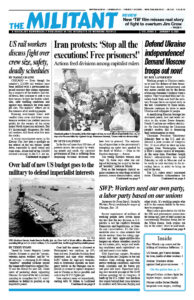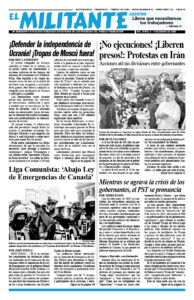CHICAGO — Even though the country’s 115,000 rail workers have been saddled with a government-imposed contract that unions representing a majority of the workers had voted down, they continue to seek to use their unions to fight for livable schedules, safer working conditions and against boss demands for even more job cuts. The workers’ efforts are in the interests of all working people.
Running ever-longer trains with smaller train crews and fewer maintenance workers has yielded massive profits for the owners of the seven major North American railroads. But it’s increasingly dangerous for both rail workers and those who live near the tracks.
A recent investigative series in the Kansas City Star puts a spotlight on the effects of the rail bosses’ profit drive, especially in small towns and rural areas. About half of the 130,000 railroad crossings in the U.S. are unprotected, with no bells, lights or gates to warn drivers of oncoming trains. The rail barons say it’s not their responsibility to install these devices, that it’s up to state and local governments to fund such projects. Then they turn around and say they should get the contracts to do the work, since they’re experts, and should be paid profitably with public money.
And the prices charged by the railroads have soared recently. “The railroads increased the cost to upgrade a crossing … to $300,000 and more,” train crash investigator Bob Comer told the Star. But federal funding hasn’t risen, “so the number of crossing upgrades were reduced greatly, but the railroads were still getting all of the money to do the work every year.”
The human costs were brought home in June 2022 when an Amtrak passenger train hit a dump truck on an unprotected BNSF Railway crossing near Mendon, Missouri, killing four people. After the crash, the rail bosses sued the company whose truck was involved.
Of course, the lawsuit doesn’t mention the fact that farmers and neighbors had complained for several years about the condition of that crossing, which caused vehicles to get stuck on the tracks. Nor the fact that the same crossing was put on a list in 2021 to have gates and lights installed, but nothing had been done a year later.
Another article in the Star took up the potential impact of the proposed merger of the Canadian Pacific Railway and Kansas City Southern.
The paper spoke to residents of Camanche, Iowa, population 4,300. Many have packed City Council meetings to oppose the merger because it could triple the number of trains passing through. The town is 1 mile long, and slow or stopped trains can trap a quarter of the population between the rail line and the Mississippi River.
Paul Varner, the mayor pro-tem, is a retired firefighter and EMT. “I’ve had all seven of these crossings blocked, we’re doing CPR on a guy in the back of the ambulance, and we can’t get across the tracks to get him to the hospital,” Varner told the Star. “It’s happened, because I’ve experienced it.”
Urban areas are affected as well. Houston City Council member Robert Gallegos said that already this year “we have over 900 cases where EMS vehicles could not get through because of stalled trains.”
As carriers have increased train lengths — two- to three-mile-long monsters are now common — the problem gets worse.
Bosses disdain for workers, townspeople
Jakob Forsgren, chairman of Brotherhood of Maintenance of Way Employees Lodge 1320 in Lincoln, Nebraska, said the issues described in the Kansas City Star rang true to his experience. His union builds and maintains the tracks and surrounding areas.
He told the Militant that he’s had to argue with management to give advance notice to residents about long-planned work that would block crossings for hours. “I was told it wasn’t the railroad’s problem.”
Another Star article reported on the death of CSX conductor Paul Payne in Ohio in the fall of 2020. Payne was struck by a tree limb while riding on the side of a car, in a spot where other workers had already reported overgrown vegetation.
“This one hit deep, as maintaining brush near the tracks is something we used to have a machine doing almost year-round,” Forsgren said. “The first positions to go every time there is a reduction are machine operator jobs that the railroad doesn’t deem essential to keeping the track in a condition where they don’t have to limit speed. You’ll notice most right of ways have weeds eight feet tall because they cut those jobs. And it causes visibility issues for drivers at train crossings.”
The dangers of long trains and maintenance cuts were underlined by one of the latest derailments. Twenty-seven cars on a Union Pacific train traveling on BNSF track through Victorville, California, went off the rails Dec. 20, closing both main lines for a day. Luckily, this time the cars didn’t end up on a nearby highway, and the train was carrying iron ore, not hazardous materials.
UP pushes getting rid of conductors
The rail bosses are campaigning to cut freight rail crew size to just one worker, the engineer. They say this significant reduction in workers would be safe because of the recent introduction of Positive Train Control, which monitors and can interfere with train speeds. Union Pacific says it is negotiating with unions to conduct a test program to replace road conductors with a “ground-based expeditor.” This would do nothing to help the engineer drive the train or replace having two sets of eyes on conditions. The “expediters” would be dispatched to drive out to a disabled train to deal with problems currently handled by the conductor. Think about massive trains blocking tracks in your town.
Into the 1990s, train crews included four or five workers, including a couple riding in a caboose at the rear of the train. Now the bosses have driven that down to a conductor and an engineer on the head end, and they want more. For them, fewer workers means higher profits — safety be damned.
Reporting on the UP “expeditor” test, Railfan & Railroad magazine noted, “BNSF Railway tried to negotiate a similar program with its unions a few years ago, but it was flatly rejected.”
On Dec. 12 the Brotherhood of Locomotive Engineers and Trainmen announced that longtime union President Dennis Pierce narrowly lost reelection to Edward Hall, a working engineer and local official from Arizona. A majority of the union’s 30,000 members didn’t vote. The election result is widely seen as reflecting workers’ dissatisfaction with the results of the contract fight.
Four days later Pierce announced he would retire at the end of the year, rather than contest the vote.
“The membership must stand united in the fight against the rail carriers, and stop blaming their union and its officers for the actions of those carriers,” Pierce wrote. “You have every right to be enraged at the rail carriers, turn that into being engaged in your union.”
These are some of the key issues facing rail workers and their unions on the heels of the government’s imposition of their new contract. Discussion and debate on how to defend jobs, safety, and working conditions continue across the industry.
Naomi Craine is a conductor and member of SMART-TD Local 1494.

